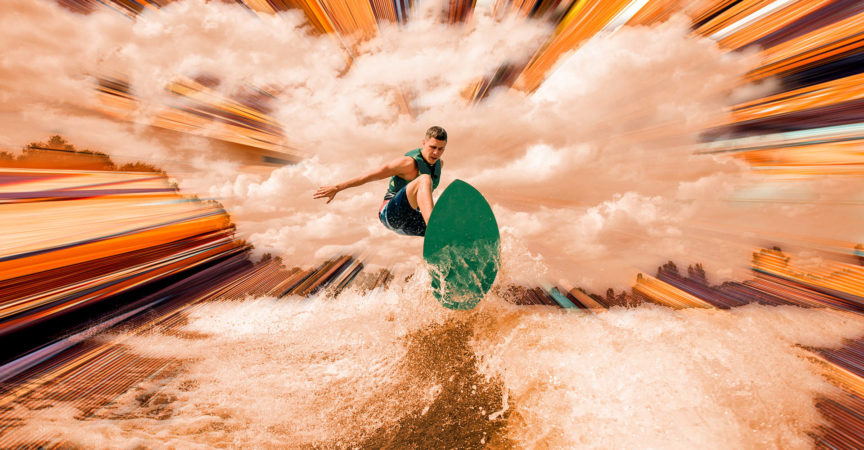Ps Channels and Masks with Deke McLelan
Release date:2018, September 25
Duration:07 h 37 m
Author:Deke McClelland
Skill level:Intermediate
Language:English
Exercise files:Yes
Learn how to leverage masks and channels to isolate areas of an image for making enhancements. Join Photoshop expert Deke McClelland as he takes you step by step through working with channels and masks in Adobe Photoshop. First, Deke explains how channels and masks work. Then he shows how to make selections and use the Color Range command and the Focus Area command. Next, he covers refining selections, extracting masks, blending, and mixing. Additionally, Deke demonstrates how to put all of the layers together into a final composite.
Topics include:
Working with the different channels
Creating the best masks
Enhancing selections text display
The Color Range command
Defining a selection
The Focus Area command
Applying global refinements
Refining selections and masks
Working with alpha channels
Extracting masks from channels
Working with blend modes
Working with the Refine Edge adjustment
Compositing
Introduction
Welcome to Channels and Masks 5m 20s
Loading Deke’s custom dekeKeys shortcuts 5m 58s
Adjusting the RGB and CMYK color settings 6m 52s
Setting up a pro-level workspace 6m 2s
Thumbnails and transparency 5m 48s
1. How Channels Work
It all starts with a channel 1m 49s
Introducing the Channels panel 4m 25s
How color channels work 6m 5s
Viewing channels in color 4m 12s
How RGB works 4m 15s
Single-channel grayscale 6m 21s
Drafting a mask with Black & White 7m 18s
The other 3-channel mode: Lab 6m 26s
The final color mode: CMYK 8m 7s
How CMYK works 5m 49s
Mask in RGB. copy to CMYK 8m 25s
2. How Masks Works
The alpha channel is home to the mask 1m 34s
The origin of the alpha channel 3m 48s
How masks work 7m 32s
Saving a selection as a layer mask 6m 6s
Creating an alpha channel 5m 44s
The Save Selection as Channel icon 7m 51s
Loading a selection from a channel 6m 31s
Loading a selection from a layer 5m 5s
Loading a selection from a different image 6m 14s
Sweetening the final composition 4m 55s
3. The Color Range Command
The best selection tools are commands 2m 9s
A brief Magic Wand refresher 4m 36s
Introducing the Color Range command 4m 15s
Working in the Color Range dialog box 4m 56s
Localized color clusters 5m 45s
Selecting complex organic details 5m 59s
Using Color Range to augment a mask 4m 27s
Finessing and feathering a layer mask 6m 43s
Creating a zoom effect with Pinch 7m 2s
Isolating Color Range inside a marquee 7m 6s
Inverting everything with type 6m 58s
Increasing the legibility of type 4m 1s
4. Select – Subject
Just choose a command and let it run 1m 44s
Introducing Select – Subject 3m 27s
Select – Subject vs. Color Range 4m 1s
Combining selections 6m 1s
Softening edges with the Blur tool 7m 40s
Smoothing edges with the Smudge tool 5m 29s
Adding depth of field to a background 6m 54s
5. The Focus Area Command
The Hail Mary of automated selections 1m 32s
Edges vs. noise 3m 40s
A brief Quick Selection refresher 5m 19s
Expanding a selection with Select – Similar 5m 43s
Introducing the Focus Area command 7m 39s
Using the Focus Area brush 4m 58s
Focus Area vs. Select – Subject 6m 38s
Bringing in some better hair 5m 53s
Viewing mask and image at the same time 7m 4s
Non-destructive feather and density 4m 51s
Masking a gradient layer 4m 44s
6. Refining Selections and Masks
The joy of automated refinement 2m 15s
Introducing Select and Mask 6m 17s
Applying global refinements 2m 53s
Edge Detection: Radius and Smart Radius 3m 14s
Painting with the Refine Edge brush 3m 15s
Decontaminating colors 6m 23s
Selecting before you refine 4m 29s
The legacy Refine Edge command 4m 27s
Further refining with Refine Mask 4m 39s
Matching the lighting of your scene 2m 57s
7. Extracting Masks from Channels
Mastering channel operations 2m 55s
Introducing the Calculations command 2m 14s
Previewing channels with Calculations 4m 37s
Blending two channels together 5m 20s
Increasing the contrast of a channel 6m 25s
Filling in regions with the Brush tool 8m 32s
Using the Add and Subtract modes 6m 50s
The Black and White Point eyedroppers 3m 5s
Soft Light, Overlay, and Hard Mix 3m 25s
Painting with the Overlay mode 5m
Combining alpha channels to make a mask 4m 38s
8. Compositing: Putting It All Together
The power of compositing 2m 7s
Smooth edges and color fringing 5m 6s
Assigning a shortcut to Refine Edge 3m 23s
Correcting wispy edges with Refine Mask 4m 10s
Bolstering hair or fur with a blended layer 4m 20s
Combining your refined layer masks 5m 17s
Dressing up a bad background 4m 35s
Masking a background image 5m 59s
From alpha channel to filter mask 2m 28s
Darkening a sky with Gradient Overlay 2m 33s
Creating a synthetic snow effect 4m 41s
Enhancing your snowflakes 4m 32s
Adding a snowflake bokeh on the lens 3m 42s
Conclusion
Wrapping it all up 4m 50s
0 – Introduction
01 – Welcome to Channels and Masks
02 – Loading Dekes custom dekeKeys shortcuts
03 – Adjusting the RGB and CMYK color settings
04 – Setting up a pro-level workspace
05 – Thumbnails and transparency
1 – 1. How Channels Work
06 – It all starts with a channel
07 – Introducing the Channels panel
08 – How color channels work
09 – Viewing channels in color
10 – How RGB works
11 – Single-channel grayscale
12 – Drafting a mask with Black & White
13 – The other 3-channel mode- Lab
14 – The final color mode- CMYK
15 – How CMYK works
16 – Mask in RGB, copy to CMYK
2 – 2. How Masks Works
17 – The alpha channel is home to the mask
18 – The origin of the alpha channel
19 – How masks work
20 – Saving a selection as a layer mask
21 – Creating an alpha channel
22 – The Save Selection as Channel icon
23 – Loading a selection from a channel
24 – Loading a selection from a layer
25 – Loading a selection from a different image
26 – Sweetening the final composition
3 – 3. The Color Range Command
27 – The best selection tools are commands
28 – A brief Magic Wand refresher
29 – Introducing the Color Range command
30 – Working in the Color Range dialog box
31 – Localized color clusters
32 – Selecting complex organic details
33 – Using Color Range to augment a mask
34 – Finessing and feathering a layer mask
35 – Creating a zoom effect with Pinch
36 – Isolating Color Range inside a marquee
37 – Inverting everything with type
38 – Increasing the legibility of type
4 – 4. Select – Subject
39 – Just choose a command and let it run
40 – Introducing Select – Subject
41 – Select – Subject vs. Color Range
42 – Combining selections
43 – Softening edges with the Blur tool
44 – Smoothing edges with the Smudge tool
45 – Adding depth of field to a background
5 – 5. The Focus Area Command
46 – The Hail Mary of automated selections
47 – Edges vs. noise
48 – A brief Quick Selection refresher
49 – Expanding a selection with Select – Similar
50 – Introducing the Focus Area command
51 – Using the Focus Area brush
52 – Focus Area vs. Select – Subject
53 – Bringing in some better hair
54 – Viewing mask and image at the same time
55 – Non-destructive feather and density
56 – Masking a gradient layer
6 – 6. Refining Selections and Masks
57 – The joy of automated refinement
58 – Introducing Select and Mask
59 – Applying global refinements
60 – Edge Detection- Radius and Smart Radius
61 – Painting with the Refine Edge brush
62 – Decontaminating colors
63 – Selecting before you refine
64 – The legacy Refine Edge command
65 – Further refining with Refine Mask
66 – Matching the lighting of your scene
7 – 7. Extracting Masks from Channels
67 – Mastering channel operations
68 – Introducing the Calculations command
69 – Previewing channels with Calculations
70 – Blending two channels together
71 – Increasing the contrast of a channel
72 – Filling in regions with the Brush tool
73 – Using the Add and Subtract modes
74 – The Black and White Point eyedroppers
75 – Soft Light, Overlay, and Hard Mix
76 – Painting with the Overlay mode
77 – Combining alpha channels to make a mask
8 – 8. Compositing- Putting It All Together
78 – The power of compositing
79 – Smooth edges and color fringing
80 – Assigning a shortcut to Refine Edge
81 – Correcting wispy edges with Refine Mask
82 – Bolstering hair or fur with a blended layer
83 – Combining your refined layer masks
84 – Dressing up a bad background
85 – Masking a background image
86 – From alpha channel to filter mask
87 – Darkening a sky with Gradient Overlay
88 – Creating a synthetic snow effect
89 – Enhancing your snowflakes
90 – Adding a snowflake bokeh on the lens
9 – Conclusion
91 – Wrapping it all up





 Channel
Channel





